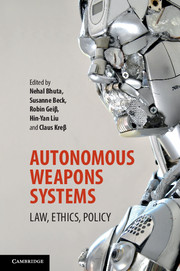Book contents
- Frontmatter
- Contents
- List of contributors
- Acknowledgements
- PART I Introduction
- PART II Meanings of autonomy and human cognition under automation
- PART III Autonomous weapons systems and human dignity
- PART IV Risk, transparency and legal compliance in the regulation of autonomous weapons systems
- 7 Judgment, liability and the risks of riskless warfare
- 8 Autonomous weapons systems and transparency: towards an international dialogue
- 9 A human touch: autonomous weapons, DoD Directive 3000.09 and the interpretation of ‘appropriate levels of human judgment over the use of force’
- 10 Autonomous weapons systems: managing the inevitability of ‘taking the man out of the loop’
- PART V New frameworks for collective responsibility
- PART VI New frameworks for individual responsibility
- PART VII Conclusion
- Index
8 - Autonomous weapons systems and transparency: towards an international dialogue
from PART IV - Risk, transparency and legal compliance in the regulation of autonomous weapons systems
Published online by Cambridge University Press: 05 August 2016
- Frontmatter
- Contents
- List of contributors
- Acknowledgements
- PART I Introduction
- PART II Meanings of autonomy and human cognition under automation
- PART III Autonomous weapons systems and human dignity
- PART IV Risk, transparency and legal compliance in the regulation of autonomous weapons systems
- 7 Judgment, liability and the risks of riskless warfare
- 8 Autonomous weapons systems and transparency: towards an international dialogue
- 9 A human touch: autonomous weapons, DoD Directive 3000.09 and the interpretation of ‘appropriate levels of human judgment over the use of force’
- 10 Autonomous weapons systems: managing the inevitability of ‘taking the man out of the loop’
- PART V New frameworks for collective responsibility
- PART VI New frameworks for individual responsibility
- PART VII Conclusion
- Index
Summary
Introduction
The international debate around autonomous weapons systems (AWS) has addressed the potential ethical, legal and strategic implications of advancing autonomy, and analysis has offered myriad potential concerns and conceivable benefits. Many consider autonomy in selecting and engaging targets to be potentially revolutionary, yet AWS developments are nascent, and the debates are, in many respects and necessarily, heavily circumscribed by the uncertainty of future developments. In particular, legal assessments as to whether AWS might be used in compliance with the conduct of hostilities rules in international humanitarian law (IHL) are at present largely predicated upon a forecast of future facts, including about the sophistication of weapon technologies, likely capacities and circumstances of use, as well as the projected effectiveness of state control over any use.
To conclusively assess legal compliance, detailed information about the AWS as developed or used would be required. However, to date, only minimal attention has been paid to transparency in the AWS context. What kinds of AWS information (if any) should governments share, with whom and on what basis? How will the international community know if autonomy is developed in critical functions and, if AWS are deployed, if they are used in compliance with international law? How might autonomy developments be monitored to enable fact-based legal analysis? Or, if autonomous targeting is prohibited or specifically regulated, how might compliance best be assured? Will existing institutions, norms or requirements for transparency be adequate? These crucial questions have not yet been debated.
This chapter explores the challenge of fact-based legal assessments for autonomous systems, and proposes that the international community begin to focus directly and systematically on transparency around AWS development and use. As a step towards deepening an international AWS transparency dialogue, this chapter offers a broad framework for disentangling distinct categories of transparency information, relationships and rationales. Given the lack of an existing well-defined transparency architecture for weapons development and the use of lethal force, transparency discussions should not wait until AWS substantive debates further mature or for the international community to settle on a response to the substantive concerns raised. Rather, transparency should be analysed alongside ongoing legal, ethical and strategic debates. Without attending to transparency, states risk developing autonomy in an environment that lacks information-sharing norms designed to advance lawful weapon use and development, democratic legitimacy and states’ strategic and security interests.
- Type
- Chapter
- Information
- Autonomous Weapons SystemsLaw, Ethics, Policy, pp. 164 - 184Publisher: Cambridge University PressPrint publication year: 2016
- 3
- Cited by



